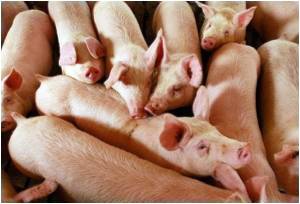
Pigs are an important source of new human strains of influenza A, such as the 2009-10 H1N1 pandemic that emerged in Mexico and infected an estimated fifth of the world's population.
Pigs can act as a "mixing vessel" in a process known as reassortment, brewing new flu strains from swine, poultry and human viruses in areas where they live in close proximity.
Such new hybrids can be deadly -- tens of millions of people died in flu pandemics in 1918, 1957 and 1968.
Luckily, the 2009 strain was about as lethal as the ordinary seasonal flu, though highly infectious.
China is currently in the grips of a deadly H7N9 bird flu virus that has killed 27 people since March, mainly in the country's east -- overlapping with the study area.
Advertisement
An article in the science journal Nature last month highlighted that H7N9 seems to be circulating in areas of China that have large populations of pigs and humans "providing opportunities for further adaptation to mammals and for reassortment with human- or pig-adapted viruses".
Advertisement
Such information may be useful to prevent future pandemic jumps from animals to humans.
The team analysed the results of tests for virus infection at time of slaughter, as well as tests for antibodies which would indicate the pig had previously been infected and was now immune.
They observed a drop in positive virus tests by the time the pigs reached the abattoir but, worryingly, concluded this did not mean there was less infection.
"Instead, it reflects higher rates of influenza circulation on the farms where pigs are raised, so that they have already been infected (and so they're immune) by the time they're going to slaughter," co-author James Lloyd-Smith of the University of California in Los Angeles told AFP by email.
The conclusion was derived from a corresponding rise in positive antibody tests.
"The prevalence of infection in swine has not decreased and so the risk of spillover to humans or birds is constant or growing," added Lloyd-Smith.
China is a priority for flu surveillance given the high densities of humans, swine and fowl in the region, the team wrote.
"Currently, China produces and consumes almost 50 percent of the world's pork, requiring an enormous swine population."
The authors stressed their findings did not mean that flu was more prevalent in pigs in China than in other countries for which data mostly did not exist.
The Chinese data was a rare example of long-term, systematic surveillance of influenza in swine, and should be commended, they said.
But important lessons can be extrapolated for application worldwide -- mainly to boost surveillance.
A case in point -- the team said elements of the H1N1 pandemic strain had been circulating undetected in swine for more than 10 years before the 2009 outbreak started in Mexico.
Keeping an eye on influenza spread among pigs could "help us to avoid such nasty surprises in the future," said Lloyd-Smith.
Last week, a study in the journal Science showed it was possible for H1N1 to swap genes with H5N1 bird flu, which is deadly for humans but not transmissible from person to person, to create a hybrid that can spread in the air between mammals -- in that case guinea pigs.
Source-AFP









